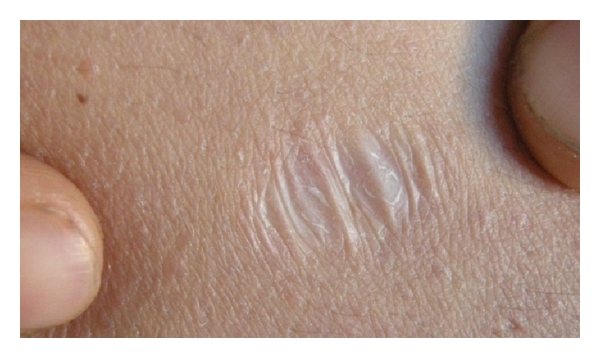|
Variola
Smallpox was an infectious disease caused by Variola virus (often called Smallpox virus), which belongs to the genus '' Orthopoxvirus''. The last naturally occurring case was diagnosed in October 1977, and the World Health Organization (WHO) certified the global eradication of the disease in 1980, making smallpox the only human disease to have been eradicated to date. The initial symptoms of the disease included fever and vomiting. This was followed by formation of ulcers in the mouth and a skin rash. Over a number of days, the skin rash turned into the characteristic fluid-filled blisters with a dent in the center. The bumps then scabbed over and fell off, leaving scars. The disease was transmitted from one person to another primarily through prolonged face-to-face contact with an infected person or rarely via contaminated objects. Prevention was achieved mainly through the smallpox vaccine. Once the disease had developed, certain antiviral medications could potentially ... [...More Info...] [...Related Items...] OR: [Wikipedia] [Google] [Baidu] |
Smallpox Vaccine
The smallpox vaccine is used to prevent smallpox infection caused by the variola virus. It is the first vaccine to have been developed against a contagious disease. In 1796, British physician Edward Jenner demonstrated that an infection with the relatively mild cowpox virus conferred immunity against the deadly smallpox virus. Cowpox served as a natural vaccine until the modern smallpox vaccine emerged in the 20th century. From 1958 to 1977, the World Health Organization (WHO) conducted a global vaccination campaign that eradicated smallpox, making it the only human disease to be eradicated. Although routine smallpox vaccination is no longer performed on the general public, the vaccine is still being produced for research, and to guard against bioterrorism, biological warfare, and mpox.Anderson MG, Frenkel LD, Homann S, and Guffey J. (2003), "A case of severe monkeypox virus disease in an American child: emerging infections and changing professional values"; ''Pediatr Infect Dis ... [...More Info...] [...Related Items...] OR: [Wikipedia] [Google] [Baidu] |
Orthopoxvirus
''Orthopoxvirus'' is a genus of viruses in the family ''Poxviridae'' and subfamily ''Chordopoxvirinae''. Vertebrates, including mammals and humans, and arthropods serve as natural hosts. There are 12 species in this genus. Diseases associated with this genus include smallpox, cowpox, horsepox, camelpox, and mpox. The most widely known member of the genus is Variola virus, which causes smallpox. It was eradicated globally by 1977, through the use of Vaccinia virus as a vaccine. The most recently described species is the Borealpox virus, first isolated in 2015. Microbiology Structure Orthopoxviruses are enveloped with brick-shaped geometries and virion dimensions around 200 nm wide and 250 nm long. Genome Member viruses have linear double-stranded DNA genomes around 170–250 kb in length. Lifecycle Viral replication is cytoplasmic. Entry into the host cell is achieved by attachment of the viral proteins to host glycosaminoglycans (GAGs), which mediate cellu ... [...More Info...] [...Related Items...] OR: [Wikipedia] [Google] [Baidu] |
Eradication Of Infectious Diseases
The Extinction, eradication of infectious diseases is the reduction of the prevalence of an Infection, infectious disease in the Earth, global Host (biology), host population to zero. Two infectious diseases have successfully been eradicated: smallpox in humans, and rinderpest in ruminants. There are four ongoing programs, targeting the human diseases poliomyelitis (polio), yaws, dracunculiasis (Guinea worm), and malaria. Five more infectious diseases have been identified as potentially eradicable with current technology by the Carter Center International Task Force for Disease Eradication – measles, mumps, rubella, lymphatic filariasis (elephantiasis), and cysticercosis (pork tapeworm). The concept of disease eradication is sometimes confused with disease ''elimination'', which is the reduction of an infectious disease's prevalence in a regional population to zero, or the reduction of the global prevalence to a negligible amount. Further confusion arises from the use of t ... [...More Info...] [...Related Items...] OR: [Wikipedia] [Google] [Baidu] |
Brincidofovir
Brincidofovir, sold under the brand name Tembexa, is an antiviral drug used to treat smallpox. Brincidofovir is a prodrug of cidofovir. Conjugated to a lipid, the compound is designed to release cidofovir intracellularly, allowing for higher intracellular and lower plasma concentrations of cidofovir, effectively increasing its activity against dsDNA viruses, as well as oral bioavailability. The most common side effects include diarrhea, nausea, vomiting, and abdominal pain. It carries an FDA-mandated Boxed warning, black box warning of an increased risk of death with extended use. Brincidofovir was approved for medical use in the United States in June 2021. Medical uses Brincidofovir is Indication (medicine), indicated for the treatment of human smallpox disease caused by the variola virus. Mechanism of action Brincidofovir is a prodrug that is composed of cidofovir Conjugation (biochemistry), conjugated with a lipid molecule. The lipid aspect of the molecule takes on the ... [...More Info...] [...Related Items...] OR: [Wikipedia] [Google] [Baidu] |
Mpox
Mpox (, ; formerly known as monkeypox) is an infectious viral disease that can occur in humans and other animals. Symptoms include a rash that forms blisters and then crusts over, fever, and swollen lymph nodes. The illness is usually mild, and most infected individuals recover within a few weeks without treatment. The time from exposure to the onset of symptoms ranges from three to seventeen days, and symptoms typically last from two to four weeks. However, cases may be severe, especially in children, pregnant women, or people with suppressed immune systems. The disease is caused by the monkeypox virus, a zoonotic virus in the genus '' Orthopoxvirus''. The variola virus, which causes smallpox, is also in this genus. Human-to-human transmission can occur through direct contact with infected skin or body fluids, including sexual contact. People remain infectious from the onset of symptoms until all the lesions have scabbed and healed. The virus may spread from infected a ... [...More Info...] [...Related Items...] OR: [Wikipedia] [Google] [Baidu] |
Scarring
A scar (or scar tissue) is an area of fibrous tissue that replaces normal skin after an injury. Scars result from the biological process of wound repair in the skin, as well as in other organs, and tissues of the body. Thus, scarring is a natural part of the healing process. With the exception of very minor lesions, every wound (e.g., after accident, disease, or surgery) results in some degree of scarring. An exception to this are animals with complete regeneration, which regrow tissue without scar formation. Scar tissue is composed of the same protein (collagen) as the tissue that it replaces, but the fiber composition of the protein is different; instead of a random basketweave formation of the collagen fibers found in normal tissue, in fibrosis the collagen cross-links and forms a pronounced alignment in a single direction. This collagen scar tissue alignment is usually of inferior functional quality to the normal collagen randomised alignment. For example, scars in the ... [...More Info...] [...Related Items...] OR: [Wikipedia] [Google] [Baidu] |
Antiviral Medication
Antiviral drugs are a class of medication used for treating viral infections. Most antivirals target specific viruses, while a broad-spectrum antiviral is effective against a wide range of viruses. Antiviral drugs are a class of antimicrobials, a larger group which also includes antibiotic (also termed antibacterial), antifungal and antiparasitic drugs, or antiviral drugs based on monoclonal antibodies. Most antivirals are considered relatively harmless to the host, and therefore can be used to treat infections. They should be distinguished from virucides, which are not medication but deactivate or destroy virus particles, either inside or outside the body. Natural virucides are produced by some plants such as eucalyptus and Australian tea trees. Medical uses Most of the antiviral drugs now available are designed to help deal with HIV, herpes viruses, the hepatitis B and C viruses, and influenza A and B viruses. Viruses use the host's cells to replicate and this make ... [...More Info...] [...Related Items...] OR: [Wikipedia] [Google] [Baidu] |
Fever
Fever or pyrexia in humans is a symptom of an anti-infection defense mechanism that appears with Human body temperature, body temperature exceeding the normal range caused by an increase in the body's temperature Human body temperature#Fever, set point in the hypothalamus. There is no single agreed-upon upper limit for normal temperature: sources use values ranging between in humans. The increase in set point triggers increased muscle tone, muscle contractions and causes a feeling of cold or chills. This results in greater heat production and efforts to conserve heat. When the set point temperature returns to normal, a person feels hot, becomes Flushing (physiology), flushed, and may begin to Perspiration, sweat. Rarely a fever may trigger a febrile seizure, with this being more common in young children. Fevers do not typically go higher than . A fever can be caused by many medical conditions ranging from non-serious to life-threatening. This includes viral infection, viral, b ... [...More Info...] [...Related Items...] OR: [Wikipedia] [Google] [Baidu] |
Mummy
A mummy is a dead human or an animal whose soft tissues and Organ (biology), organs have been preserved by either intentional or accidental exposure to Chemical substance, chemicals, extreme cold, very low humidity, or lack of air, so that the recovered body does not Corpse decomposition, decay further if kept in cool and dry conditions. Some authorities restrict the use of the term to bodies deliberately embalming, embalmed with chemicals, but the use of the word to cover accidentally desiccation, desiccated bodies goes back to at least the early 17th century. Mummies of humans and animals have been found on every continent, both as a result of natural preservation through unusual conditions, and as cultural artifacts. Over one million Animal mummy, animal mummies have been found in Egypt, many of which are cats. Many of the Egyptian animal mummies are African sacred ibis, sacred ibis, and radiocarbon dating suggests the Egyptian ibis mummies that have been analyzed were from ... [...More Info...] [...Related Items...] OR: [Wikipedia] [Google] [Baidu] |
Disease Outbreak
In epidemiology, an outbreak is a sudden increase in occurrences of a disease when cases are in excess of normal expectancy for the location or season. It may affect a small and localized group or impact upon thousands of people across an entire continent. The number of cases varies according to the disease-causing agent, and the size and type of previous and existing exposure to the agent. Outbreaks include many epidemics, which term is normally only for infectious diseases, as well as diseases with an environmental origin, such as a water or Foodborne illness, foodborne disease. They may affect a region in a country or a group of countries. Pandemics are near-global disease outbreaks when multiple and various countries around the Earth are soon infected. Definition The terms "outbreak" and "epidemic" have often been used interchangeably. Researchers Manfred S. Green and colleagues propose that the latter term be restricted to larger events, pointing out that ''Chambers Diction ... [...More Info...] [...Related Items...] OR: [Wikipedia] [Google] [Baidu] |







